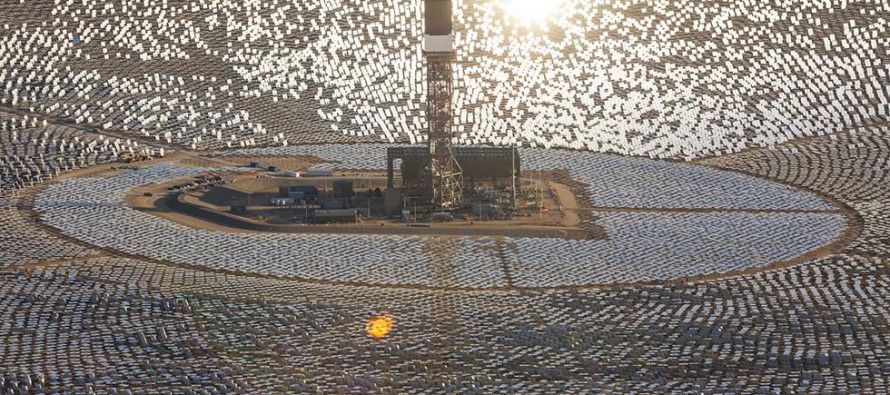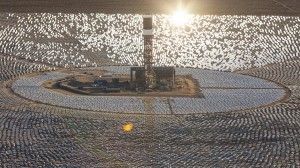Ivanpah solar power shifts pollution to the desert

This is Part 1 of a two-part series on Ivanpah solar power.
 It’s supposed to be the latest thing in solar power.
It’s supposed to be the latest thing in solar power.
Gov. Jerry Brown and other state politicians tout the new Ivanpah Concentrated Solar Thermal Power Plant in the Mojave Desert as a showcase of the state’s green-energy future. The plant will help the state meet the target of 33 percent of state electricity coming from renewable sources, as mandated by a 2011 law signed by the governor.
Unfortunately, it’s about as “green” as a souped-up 1957 Chevy hot rod belching exhaust fumes without a catalytic converter. Southern California hot rodders used to race their modified cars on empty, dry lakebeds in the desert. And the Ivanpah solar also is located on a dry lake-bed near the California-Nevada borderline 35 miles west of Las Vegas.
Public TV station KCET estimated Ivanpah’s increased emissions:
“The plant’s total CO2 footprint from burning natural gas would rise to just above 92,200 tons per year, approximately equivalent to the annual greenhouse gas output of 16,500 average passenger cars.”
Ivanpah’s application to the Desert Air Resources Board says it will emit 95,545 tons of Greenhouse Gases per year that would contribute to smog, excluding any carbon dioxide (CO2) emissions.
Ivanpah is the largest solar power plant in the world, encompassing 4,000-acres of land with 173,400 heliostatic mirrors used to focus heat toward three central towers rising as high as 40-story buildings, each driving a steam turbine to generate electricity.
Different types of solar
There are four different types of solar technology, as described by Go Solar California, an initiative of the state government:
- “Photovoltaic (PV) systems, which convert sunlight directly to electricity by means of PV cells made of semiconductor materials.
- “Concentrating solar power (CSP) systems, which concentrate the sun’s energy using reflective devices such as troughs or mirror panels to produce heat that is then used to generate electricity.
- “Solar water heating systems, which contain a solar collector that faces the sun and either heats water directly or heats a ‘working fluid’ that, in turn, is used to heat water.
- “Transpired solar collectors, or ‘solar walls,’ which use solar energy to preheat ventilation air for a building.”
Ivanpah uses No. 2: CSP, also called “solar thermal technology.” It uses heat to produce steam-generated electricity.
Turbines
Each of Ivanpah’s three steam turbines has auxiliary boilers that are used to pre-heat fluid in the early morning, to keep fluid warm at night, and to boost production especially during cloudy days or when there are desert dust storms. Natural gas is needed to heat the auxiliary boilers when the sun is down or covered by clouds.
You have to leave a thermal solar power plant idling on natural gas fuel rather than on clean solar power.
As reported in the Sacramento Bee, In Feb. 2013, Gov. Jerry Brown certified Ivanpah as a special “leadership project” that qualified for fast tracking under the 2011 California Environmental Quality Act reforms. The Bee wrote:
“Brown’s office said the California Air Resources Board has certified that the $1 billion solar project will not generate additional greenhouse gas emissions during construction, and that it will provide enough electricity to power about 264,000 homes.”
Fast-tracking
By fast-tracking Ivanpah’s construction, opposition to the impact of the project on bird kills, desert tortoise habitat, and potentially dangerous glare from its mirrors on commercial passenger aircraft was overcome. But now that the project is operational, another loophole in environmental laws designed specifically for solar projects like Ivanpah is coming into light.
Burning natural gas to pre-heat the boilers is generating 383.7 tons of carbon dioxide (C02) per operating day at Ivanpah. C02 is classified as a greenhouse gas that contributes to global warming.
This was overlooked by regulators at the California Energy Commission, large electric utilities such as PG&E and Edison that have signed 25-year contracts to buy solar power from Ivanpah, and even co-investor Google Inc. that put $168 million into the project.
Back on October 4, 2011, Brown signed Senate Bill 226, amending the California Environmental Quality Act so that “cumulative” impacts from a number of related public projects do not disqualify a project from categorical exemptions under certain circumstances. The bill’s author was state Sen. Joe Simitian, D-Palo Alto, who chaired the Senate Committee on Environmental Quality at that time. Simitian’s constituents included Google.
Brown signed SB226 into law over the opposition of his own party’s 2010 political platform. Oddly however, no opposition was filed by environmental organizations to SB226 while in committee review in the Legislature.
By 2012, Brown sanctified more CEQA reforms to fast track pet projects by calling them “the Lord’s work.”
Ivanpah was cleared to go online.
Part 2 will be on Ivanpah as a hybrid gas-solar plant
Related Articles
Draconian water plan unveiled
MAY 3, 2010 By SUSAN M. TRAGER Water is the lifeblood of California. Throughout the state’s history, it has formed
California’s Beltway delegation double-dips on pensions
They’re called double-dippers: those who take a pension payout from one government job while earning a salary doing another. Last year
Redevelopment is Prop. 13 in Reverse
JUNE 28, 2011 by WAYNE LUSVARDI To California redevelopment advocates, the policy brings the Midas touch to cities, turning everything




